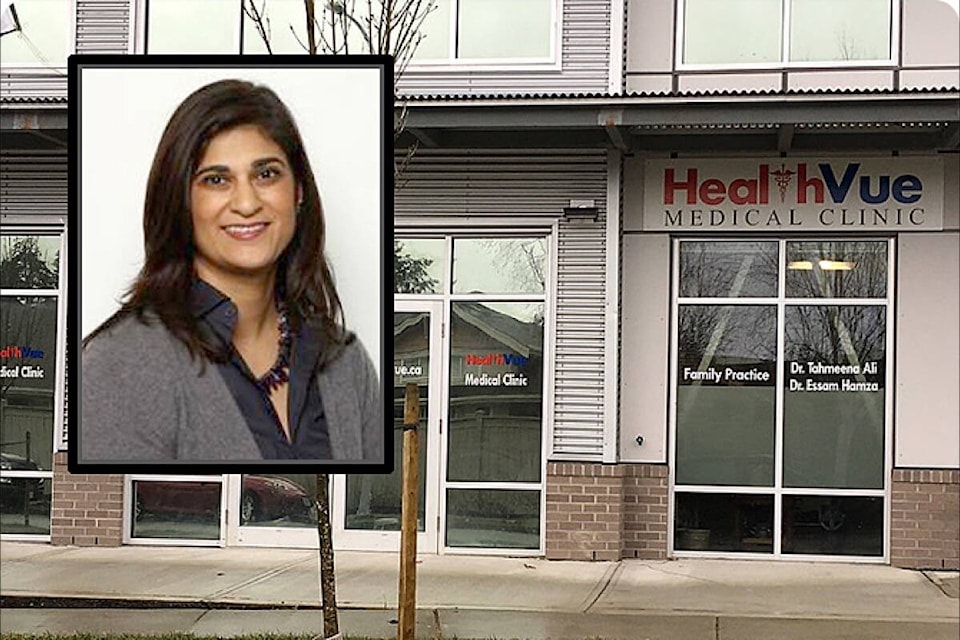A South Surrey physician who last year described herself as “approaching a breaking point” due to workload said this week the province’s new fee model for B.C. doctors has given her and many others in the profession much-needed optimism.
“From a year ago, where I truly was ready to toss in the towel and leave my family practice… to recognizing that I’m in it for another few decades and happy to continue to provide the care to my patients that I really enjoy doing is a huge 180 that I feel very blessed to be able to say,” Dr. Tahmeena Ali said Monday (March 13).
Ali is among more than 2,000 family doctors in B.C. who have so far signed on to the new Longitudinal Family Practice (LFP) payment model that took effect on Feb. 1.
The agreement – negotiated by the province, Doctors of BC and BC Family Doctors over the course of nine months and ratified by doctors in December – increased the gross salary of physicians by 54 per cent, as part of a system that compensates them for visits, hours, volume and complexity of patients.
For those who opt in, it replaces the previous fee-for-service model that paid $30 per patient regardless of the complexity of the individual’s health-care needs; a system that family doctors had long-pegged as one of the primary causes of the province’s doctor shortage.
Ali wrote Peace Arch News in April 2022 to express her frustration, saying she was “on the brink of quitting every single day.”
“Last week, I contemplated taping a sign to the front of my clinic door. It would read: ‘I regret to inform you that the clinic is now permanently closed. You will have to find a new family physician,’” she wrote.
She said Monday that the process which led to the new model began the following month – following a rally that brought hundreds to the B.C. legislature grounds in Victoria – and was a game-changer.
READ MORE: B.C. family doctor shortage sparks hundreds to rally in Victoria
“For many of us, we hung on because we knew, these negotiations, once they started happening… that there was hope.”
As president-elect of B.C. Family Doctors, Ali was among those who helped design the plan “from the ground up,” including simplifying fee codes used in billing services. That one move alone, she noted – bringing the number of codes down to 11 from “hundreds” – made a significant dent in administrative work.
“It was a very special moment on Feb. 1 when I started billing these codes that I helped create,” Ali said. “Now, I don’t have to spend that time doing that. I can actually take care of patients.”
Ali said while her workload hasn’t changed, other physicians she’s spoken to say they “feel that they can come off the treadmill,” and no longer need to see patients at a fast pace in order to ensure they can cover such costs as bills, staffing and overhead.
“It takes a huge weight off your shoulders.”
According to Doctors of BC, the number of doctors that had signed on to the new model as of March 3 – 2,024 – represents around 45 per cent of currently practising family doctors in the province. One hundred forty-nine are new doctors or those returning to family practice after working in other areas of the province, the organization noted in a news release.
The organization had predicted up to 60 per cent of an estimated 3,400 eligible physicians would eventually take part.
Doctors of BC president Dr. Josh Greggain said response to the new model “represents a significant shift in the way we practise.”
“We are hearing that many family doctors who had been planning to leave or retire are reconsidering that decision, which means that thousands of patients who would then be without a family doctor will continue to have one,” Greggain said in the release.
“We are also starting to recruit new and returning physicians, which creates new openings for patients who want a family doctor. Patients will benefit as the positive response continues to build momentum.”
READ MORE: $118M announced for B.C. family doctors amid new payment model transition
READ MORE: B.C. doctors ratify new agreement that includes pay increase, more rural funding
READ MORE: B.C. announces long-awaited new payment model for family doctors to launch in 2023
READ MORE: Roadblocks to solving B.C.’s doctor shortfall
Minister of Health Adrian Dix told Black Press Media in December that he believed it will result in better health-care access across the province.
Ali said all of the province’s health regions are “desperate” for family physicians, a situation the new model will “certainly” help address.
While Ali praised the collaboration that led to the new agreement, she said the family doctor shortage is a complex issue that will not resolve overnight. New medical-school seats opening in 2026 won’t add doctors to the field until at least 2032.
“It’s not going to be one simple solution. These solutions are going to take years,” Ali said.
Meanwhile, calls and emails from people looking for a family doctor continue to come to her office on a daily basis, she said.
“It’s hard on the soul, because we want to be able to say yes, or we want to be able to say, ‘no I’m not (taking new patients), but here’s someone who is,” Ali said.
“At least now I know I have some stability, so I know when I accept someone, I know I’m going to be there for the long run.”
tracy.holmes@peacearchnews.com
Like us on Facebook and follow us on Twitter www.peacearchnews.com/newsletters
